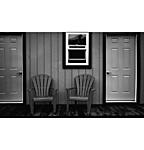
Originally Posted by
jimskelton

I was curious about Regent Royal hard dot film because of the price so set out trying to figure out how to develop it so that it would not render just black and clear. I tried flashing the negative, shooting at ISO 12, and developing in 1:20 dektol which produced some mid tones, but would often watch helplessly as the highlights turned jet black while waiting for the shadows to appear. Then some of the negatives would chemically fog. Not sure why, but it may be from the "dirty Dektol" that I was using. Time for another solution.
Enter D-23. I was originally interested in it because it only takes 2 ingredients which I can get easily in Canada (Metol and Sodium sulfite), but it's billed as a low contrast developer which piqued my interest. In researching D-23, I discovered something called "divided D-23", which technically isn't a divided developer but a 2 bath developer, the 2nd solution (.2-1.8% borax) acting as a compensating agent to bring out the shadows.
The theory behind it is that the D-23 develops the film normally. Then, if you have a negative that needs the shadows developed more, you can transfer the negative to the borax bath, being careful not to agitate it for maximum effect. Apparently, when you do this, the developer that's soaked into the gelatin gets used up quickly in the highlights and exhausts, stopping development. But the developer in the shadows continues to develop in the borax solution.
I experimented with mixing up 500ml of D-23 using 3 grams of Metol and 50 grams of sodium sulfite, diluting it 1:1 for the working developer. I tried exposing the litho negative at ISO 12, but only highlights in zone 7 appeared, with nothing more appearing in the borax solution. But exposing at ISO 3 seemed to work. Zone 7 highlights appeared after around a minute. When zone 6 highlights turned mid grey I transferred it to the borax solution and let it sit, where the magic happened. After around a minute zone 5 areas started appearing, followed by zone 4. Zone 3 took around 4 minutes to start showing up, at which point I stopped development and fixed the negative. This method seems to get around 4 or 5 stops of dynamic range, which is pretty good for litho film!
I found if given a choice, it's better to expose for around zone 4 then developing with less time in D-23, and more time in borax if you need more definition in the shadows.
Litho film is still very high contrast film, but at least you can get a few stops out of it using this method. I find it fun shooting it because it's so inexpensive.




 Reply With Quote
Reply With Quote


Bookmarks